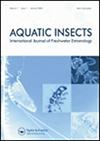一种新的Amblyospora属微孢子虫寄生虫(Hazard和Oldacre,1975),通过rDNA ITS测序从嗜盐蚊子Ochlerotus decastus(Haliday,1833)(直翅目:库蚊科)中鉴定
IF 0.6
4区 农林科学
Q4 ENTOMOLOGY
引用次数: 0
摘要
摘要来自英国维拉尔Parkgate沼泽地的Ochleroturus碎屑(Haliday,1833)被一种新的Amblyospora(Hazard和Oldacre,1975)微孢子虫寄生。系统发育分析表明,该微孢子虫的内部转录间隔区序列与迄今为止鉴定的所有已知微孢子虫不同,但与Amblyospora weiseri Lukeš和Vávra,1990和a.stictici Andreadis,1994形成分支,微孢子虫分别鉴定自Ochlerotus cantans Meigen,1818和O.sticticus Meigen(1838)。合并样本的患病率(N = 每个池5个)较低(2.37%;下限0.78%,上限5.62%),这可能是这些短暂的微咸水池栖息地周期性干涸的结果。人们对利用微孢子虫寄生虫作为新的媒介控制策略越来越感兴趣,了解这种微孢子虫及其蚊子宿主的表型可能最终为控制这种令人讨厌的叮咬物种带来新的方法。本文章由计算机程序翻译,如有差异,请以英文原文为准。
A new microsporidian parasite of the genus Amblyospora (Hazard and Oldacre, 1975) identified from the halophilic mosquito Ochlerotatus detritus (Haliday, 1833) (Diptera: Culicidae) through rDNA ITS sequencing
Abstract Ochlerotatus detritus (Haliday, 1833) from Parkgate marshes, Wirral, UK are shown to be parasitised by a new species of Amblyospora (Hazard and Oldacre, 1975) microsporidian. Phylogenetic analysis shows that Internal Transcribed Spacer sequences from this microsporidian are distinct from those of all known microsporidia identified to date, but form a clade with Amblyospora weiseri Lukeš and Vávra, 1990 and A. stictici Andreadis, 1994, microsporidia identified from Ochlerotatus cantans Meigen, 1818 and O. sticticus Meigen, 1838, respectively. Prevalence rates, from pooled samples (N = 5 per pool) were low (2.37%; lower limit 0.78%, upper limit 5.62%), which may be a consequence of these ephemeral brackish water pool habitats periodically drying out. There is increasing interest in the use of microsporidian parasites as novel vector control strategies and understanding the phenology of this microsporidian and its mosquito host may ultimately lead to new methods of control for this nuisance biting species.
求助全文
通过发布文献求助,成功后即可免费获取论文全文。
去求助
来源期刊

Aquatic Insects
生物-昆虫学
CiteScore
2.00
自引率
25.00%
发文量
27
审稿时长
>12 weeks
期刊介绍:
Aquatic Insects is an international journal publishing original research on the systematics, biology, and ecology of aquatic and semi-aquatic insects.
The subject of the research is aquatic and semi-aquatic insects, comprising taxa of four primary orders, the Ephemeroptera, Odonata, Plecoptera, and Trichoptera but also aquatic and semi-aquatic families of Hemiptera, Coleoptera, and Diptera, as well as specific representatives of Hymenoptera , Lepidoptera, Mecoptera, Megaloptera , and Neuroptera that occur in lotic and lentic habitats during part of their life cycle. Studies on other aquatic Hexapoda (i.e., Collembola) will be only accepted if space permits. Papers on other aquatic Arthropoda (e.g., Crustacea) will not be considered, except for those closely related to aquatic and semi-aquatic insects (e.g., water mites as insect parasites).
The topic of the research may include a wide range of biological fields. Taxonomic revisions and descriptions of individual species will be accepted especially if additional information is included on habitat preferences, species co-existing, behavior, phenology, collecting methods, etc., that are of general interest to an international readership. Descriptions based on single specimens are discouraged.
Detailed studies on morphology, physiology, behavior, and phenology of aquatic insects in all stadia of their life cycle are welcome as well as the papers with molecular and phylogenetic analyses, especially if they discuss evolutionary processes of the biological, ecological, and faunistic formation of the group.
 求助内容:
求助内容: 应助结果提醒方式:
应助结果提醒方式:


